|

ARCHIVE
2010
Dec.
6, 2010: Crazy Sundays
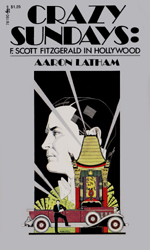 I've
spent the better part of a year tracking this one down: Amsel's
cover design for the Pocket Books' paperback edition of CRAZY
SUNDAYS: F. SCOTT FITZGERALD IN HOLLYWOOD. I finally
found it on eBay, and just received it in the mail. It was a
bit worn for wear, but I tried digitally cleaning it up a little
bit here. I've
spent the better part of a year tracking this one down: Amsel's
cover design for the Pocket Books' paperback edition of CRAZY
SUNDAYS: F. SCOTT FITZGERALD IN HOLLYWOOD. I finally
found it on eBay, and just received it in the mail. It was a
bit worn for wear, but I tried digitally cleaning it up a little
bit here.
This book
by author Aaron Latham was published numerous times in the early
1970s, including Pocket Books in 1972
and 1975,
as well Viking
in 1971. Trying to find which one donned Amsel's
cover was challenging, as no images were available.
I came
across this
alternate image a few months back, and assumed
the art was of Amsel's authorship; it bore a similar painting
style to Amsel's work of the period, but I was presumptuous.
Two things bugged me about it, too: there was no artist's signature
on the cover, and, frankly, its rather bland design did not
strike me as particularly impressive. (If anyone has more information
on this artwork, please let me know.)
I'm happy
to see that this newly (re)discovered image not only bears Amsel's
signature, but it's much more effective and striking.
Dec.
4, 2010: Mozart lives!
I
came across this album cover art on Amazon almost by chance,
but vaguely remember seeing it on prominent display in music
stores back when I was a child. Amsel did the cover art for
Time Life Music's THE MOZART COLLECTION, released in 1984 --
no doubt fueled by the enormous success of the film AMADEUS
at the time. To my knowledge, this is Amsel's last known album
cover.
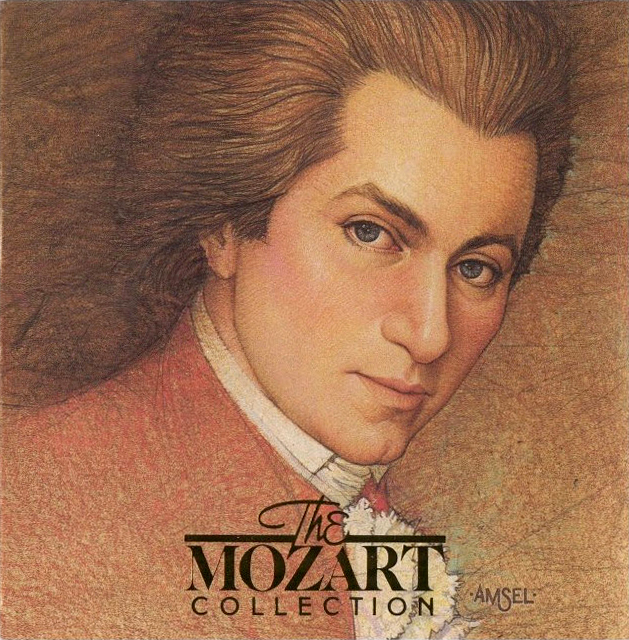
Sept.
25, 2010: R.I.P.: FRANK FRAZETTA (1928-2010)
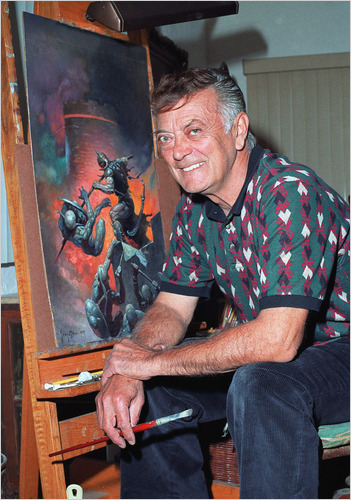 Consider
this the grandfather of belated tributes: Frank Frazetta, whose
illustrations of semi-clad, impossibly muscled warrior heroes
(and even lesser-clad, voluptuous women) pitted against against
ferocious monsters in exotic, faraway fantasy worlds, died of
a stroke last May. Consider
this the grandfather of belated tributes: Frank Frazetta, whose
illustrations of semi-clad, impossibly muscled warrior heroes
(and even lesser-clad, voluptuous women) pitted against against
ferocious monsters in exotic, faraway fantasy worlds, died of
a stroke last May.
Franzetta's
work is the stuff of legend. His covers for a number of paperback
books -- from Tarzan to John Carter of Mars -- often matched,
if not exceeded the popularity of the stories from which they
were inspired. His cover for Conan the Adventurer (pictured
here) is particularly iconic.
From
THE
NEW YORK TIMES:
Mr.
Frazetta was a versatile and prolific comic book artist who,
in the 1940s and ’50s, drew for comic strips like Al Capp’s
“Lil’ Abner” and comic books like “Famous Funnies,” for which
he contributed a series of covers depicting the futuristic adventurer
Buck Rogers.
A
satirical advertisement Mr. Frazetta drew for Mad earned him
his first Hollywood job, the movie poster for “What’s New Pussycat?”
(1965), a sex farce written by Woody Allen that starred Peter
Sellers. In 1983 he collaborated with the director Ralph Bakshi
to produce the animated film “Fire and Ice.”
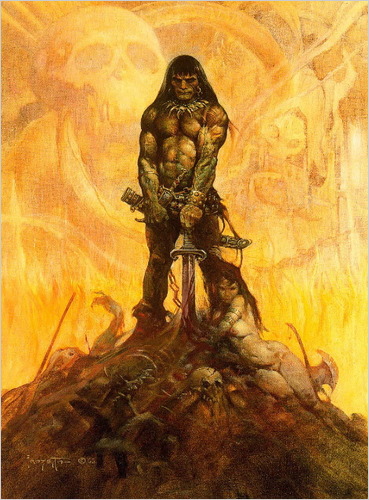 His
most prominent work, however, was on the cover of book jackets,
where his signature images were of strikingly fierce, hard-bodied
heroes and bosomy, callipygian damsels in distress. In 1966,
his cover of “Conan the Adventurer,” a collection of four fantasy
short stories written by Robert E. Howard and L. Sprague de
Camp, depicted a brawny long-haired warrior standing in repose
on top of a pile of skeletons and other detritus, his sword
thrust downward into the mound, an apparently naked young woman
lying at his feet, hugging his ankle. His
most prominent work, however, was on the cover of book jackets,
where his signature images were of strikingly fierce, hard-bodied
heroes and bosomy, callipygian damsels in distress. In 1966,
his cover of “Conan the Adventurer,” a collection of four fantasy
short stories written by Robert E. Howard and L. Sprague de
Camp, depicted a brawny long-haired warrior standing in repose
on top of a pile of skeletons and other detritus, his sword
thrust downward into the mound, an apparently naked young woman
lying at his feet, hugging his ankle.
The
cover created a new look for fantasy adventure novels and established
Mr. Frazetta as an artist who could sell books. He illustrated
many more Conan books (including “Conan the Conqueror,” “Conan
the Usurper” and “Conan the Avenger”) and works by Edgar Rice
Burroughs (including “John Carter and the Savage Apes of Mars”
and “Tarzan and the Antmen”).
“Paperback
publishers have been known to buy one of his paintings for use
as a cover, then commission a writer to turn out a novel to
go with it,” The New York Times reported in 1977, the same year
that a collection of his drawings, “The Fantastic Art of Frank
Frazetta,” sold more than 300,000 copies.
Frank
Frazzetta was born in Brooklyn on Feb. 9, 1928, and as a boy
studied painting at a local art school. (Early in his career,
he excised one z from his last name because “with one z it just
looked better,” Mr. Pistella said. “He said the two z’s and
two t’s was too clumsy.”)
Mr.
Frazetta began drawing for comic books of all stripes — westerns,
mysteries, fantasies — when he was still a teenager. He was
also a good enough baseball player to try out for the New York
Giants.
 The
popularity of Mr. Frazetta’s work coincided with the rise of
heavy metal in the early 1970s, and his otherworldly imagery
showed up on a number of album covers, including Molly Hatchet’s
“Flirtin’ With Disaster” and Nazareth’s “Expect No Mercy.” Last
year, Kirk Hammett, the lead guitarist for Metallica, bought
Mr. Frazetta’s cover artwork for the paperback reissue of Robert
E. Howard’s “Conan the Conqueror” for $1 million. The
popularity of Mr. Frazetta’s work coincided with the rise of
heavy metal in the early 1970s, and his otherworldly imagery
showed up on a number of album covers, including Molly Hatchet’s
“Flirtin’ With Disaster” and Nazareth’s “Expect No Mercy.” Last
year, Kirk Hammett, the lead guitarist for Metallica, bought
Mr. Frazetta’s cover artwork for the paperback reissue of Robert
E. Howard’s “Conan the Conqueror” for $1 million.
Mr.
Frazetta married Eleanor Kelly, known as Ellie, in 1956. She
served as his occasional model and as his business partner;
in 2000 she started a small museum of her husband’s work on
their property in East Stroudsburg, Pa. She died last year.
Mr.
Frazetta is survived by three sisters, Carol, Adel and Jeanie;
two sons, Alfonso Frank Frazetta, known as Frank Jr., and William
Frazetta, both of East Stroudsburg; two daughters, Heidi Grabin,
of Englewood, Fla., and Holly Frazetta, of Boca Grande, Fla.;
and 11 grandchildren.
After
Ellie Frazetta’s death, her children became embroiled in a custodial
dispute over their father’s work, and in December, Frank Jr.
was arrested on charges of breaking into the family museum and
attempting to remove 90 paintings that had been insured for
$20 million. In April, the family said the dispute over the
paintings had been resolved, and the Monroe County, Pa., district
attorney said he would drop the charges.
So
many art giants have passed recently -- Bernie Fuchs, Robert
McCall, Tim Hildebrandt and John Alvin among them.... Richard
Amsel and Bob Peak have been gone for a number of years now....
Drew Struzan has retired....
It's
sad, as I wonder not only who's left, but if there's even a
demand for such artistic talents anymore. Movie posters have
been reduced to bland, insert-actors'-faces-here Photoshop templates.
Even book covers, once the common, bread-and-butter market for
illustrators, are now rendered through recycled Illustrator
fonts, stamped over stock photos culled from royalty-free digital
piles.
There
are some guys left whose work I love, and are still at it. Guys
like James Gurney, William Stout, Greg Hildebrandt, and -- of
course -- my very good friend David Byrd. But ask yourself:
Where is the next great illustrator? Is there a new generation
of artists on the way? And, most importantly, will art agencies
and publishers be wise enough to put such talents to good use?
Sept.
23, 2010: This is Helen O'Connell, full-figured!
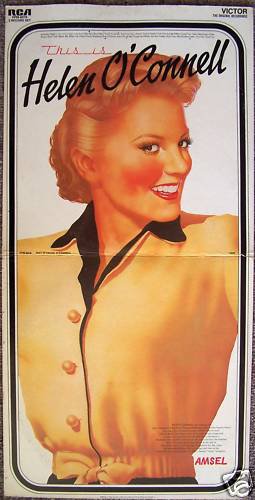 Special
thanks to Tony Hill for providing an image of Amsel's complete
double album cover for RCA Victor Records' This is Helen
O'Connell. While the front only showed an illustration
of the singer's face, we can now see that there was much more
to the artwork -- including Amsel's signature at the bottom! Special
thanks to Tony Hill for providing an image of Amsel's complete
double album cover for RCA Victor Records' This is Helen
O'Connell. While the front only showed an illustration
of the singer's face, we can now see that there was much more
to the artwork -- including Amsel's signature at the bottom!
Thanks
again, Tony!
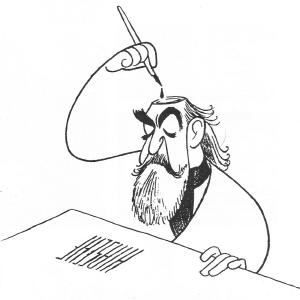 July
1, 2010: So, just who did the most TV GUIDE covers? July
1, 2010: So, just who did the most TV GUIDE covers?
I had
heard from several sources that Richard Amsel did more TV
GUIDE covers than any other artist -- and repeated that
presumed fact often on this site. But I recently read that the
legendary Al
Hirschfeld had actually matched Amsel's
number of 37 published covers, while creating an additional
four that remain unpublished. (Amsel also had at least three
-- possibly four -- that were unpublished, including this
one.)
Nevertheless,
it's remarkable to note that while Hirschfeld's covers spanned
several decades, Amsel's output was framed within just 13 years,
from 1972 to 1985. And there's no doubting that many more covers
sporting that marvellous "AMSEL" stamp would have
graced the magazine had we not lost the artist all too soon.
I'm not
so interested in the "Who did more?" question
as I am in ensuring the accuracy of this site, so if any of
you TV Guide fans know the definitive answer, it would be welcomed
wholeheartedly.
 This
seemingly innocuous tidbit is yet another reminder to me that
my tribute page is in dire need of an update -- including more
information on Richard's life and work (particularly his aspirations
to work in animation), as well as some corrections and clarifications
to what I had written back in early 2008.
I hope to get to this by the end of the summer. This
seemingly innocuous tidbit is yet another reminder to me that
my tribute page is in dire need of an update -- including more
information on Richard's life and work (particularly his aspirations
to work in animation), as well as some corrections and clarifications
to what I had written back in early 2008.
I hope to get to this by the end of the summer.
I may
have built this website, but it never would have existed without
the contributions of Richard's many friends and family members.
Nor could it thrive or be improved upon without the feedback
and input of his fans and admirers the world over.
June
13, 2010: Meeting Greg Hildebrandt
"The
Brothers Hildebrandt" are legends in the illustration world,
and especially known among sci-fi and fantasy fans for their
Star Wars movie poster and the immensely popular Lord
of the Rings calendars. Twin brothers, Greg and Tim often
collaborated on projects (exchanging "shifts" in painting
duties -- a neat ability when facing tight deadlines), as well
as worked on their own. What made their partnership so extraordinary
was not just the consistant high calibre (and volume) of their
work, but that they were so creatively sympatico, it's impossible
-- for me, at least -- to distinguish one artist's work from
the other. (Take, for example, Tim's Secret
of NIMH poster and compare it to the collaborated
works below.)
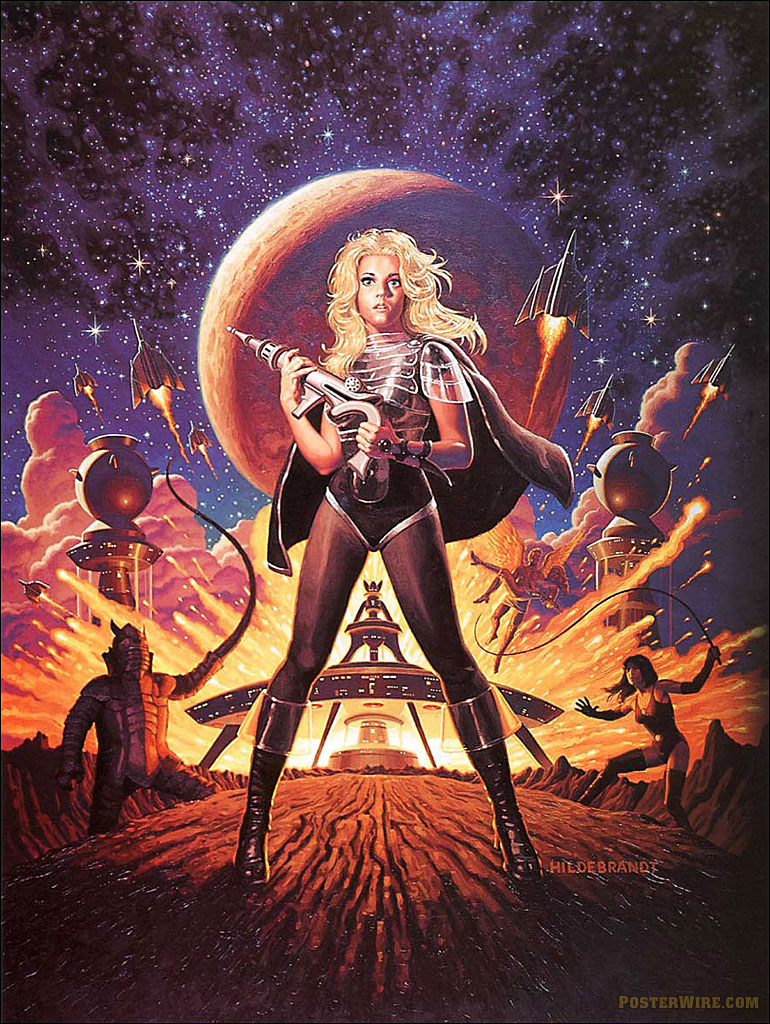 _ _
 _ _
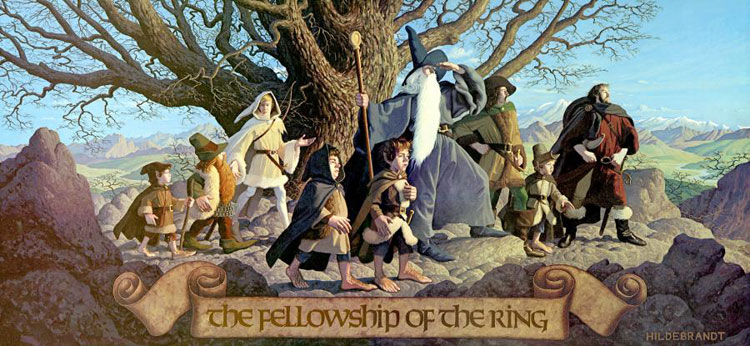
Sadly,
Tim passed away in 2006 due to complications from diabetes,
but Greg has continued their artistic legacy. I had the pleasure
of meeting him yesterday in Santa Monica, and he was extremely
kind, gracious, and receptive to my many annoying questions...
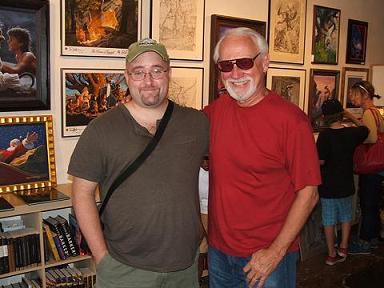 _ _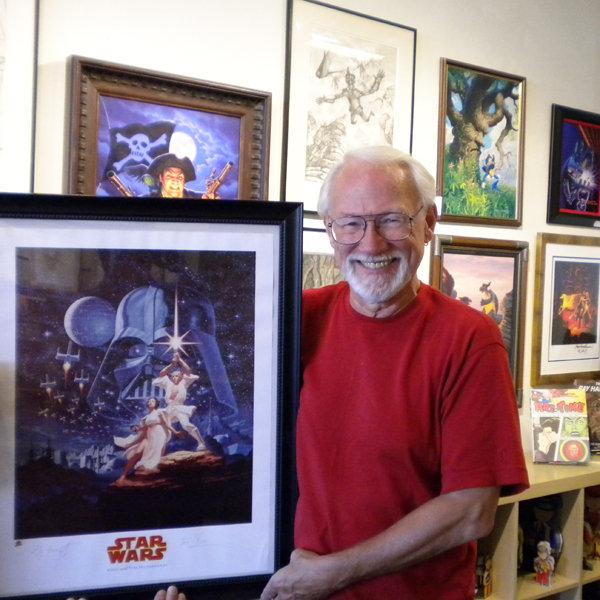
...the
first of which I was a little hesitant to ask: As he and his
brother collaborated so often throughout their careers, was
there ever any serious creative strain or severe difference
of opinions in approaching their many works? To my absolute
astonishment, Greg answered no -- and even marvelled
himself at just how well he and his late brother got along,
as close personal relationships can so often fall victim to
pressure while in the throws of creative collaboration.
Greg,
who blushed when I called him "sir" -- "Call
me Greg!", he laughed -- is a class act, and I was delighted
and honored to meet him at long last.
June
13, 2010: Comments by fellow artist Richard Adkins.
I
recently received this lovely email, and thought it was worth
sharing:
Hi,
My name is Richard Adkins and I am a huge Richard Amsel
fan. I too, am an illustrator, only a year younger than
Richard would be now. At the time I entered the field professionally,
illustration was being supplanted by photography, yet there
was just a little interest remaining in illustration, particularly
in the 70s and 80s in airbrush illustration.
I
worked for NBC from 1973 to 1980 and the network graphics
department provided newspapers and magazines with art for
upcoming programs. Newspapers particularly would take advantage
of the free NBC art for their local T.V. guides. At NBC
there were numerous artists, and each of us had the ability
to work in the style of more noted illustrators - but for
a whole lot less money. One of my "artists" that I imitated
was Richard Amsel, (the other was caricaturist Jack Davis).
The most noted of the Amselesque art I did were the "More
to Come" cards for Johnny Carson's Tonight show. Carson
hand picked the art, and he liked my illustrations ala Amsel
of famous NBC radio stars. The set was among the most popular
and "Art Direction" magazine wrote an article on them featuring
photos of the cards (although illogically in black-and-white).
I thought you might enjoy them.
Thanks
for the great Amsel work - he was far and away the best
illustrator of that period.
Sincerely,
Richard
Adkins
Thanks
to you, too, Richard! No doubt Amsel himself would have been
honored by your comments -- and your incredible work!
Bravo!
Richard
provided scans of some of his illustrations done for The
Tonight Show with Johnny Carson. You can definitely see
the homage to Amsel's work. Absolutely amazing.
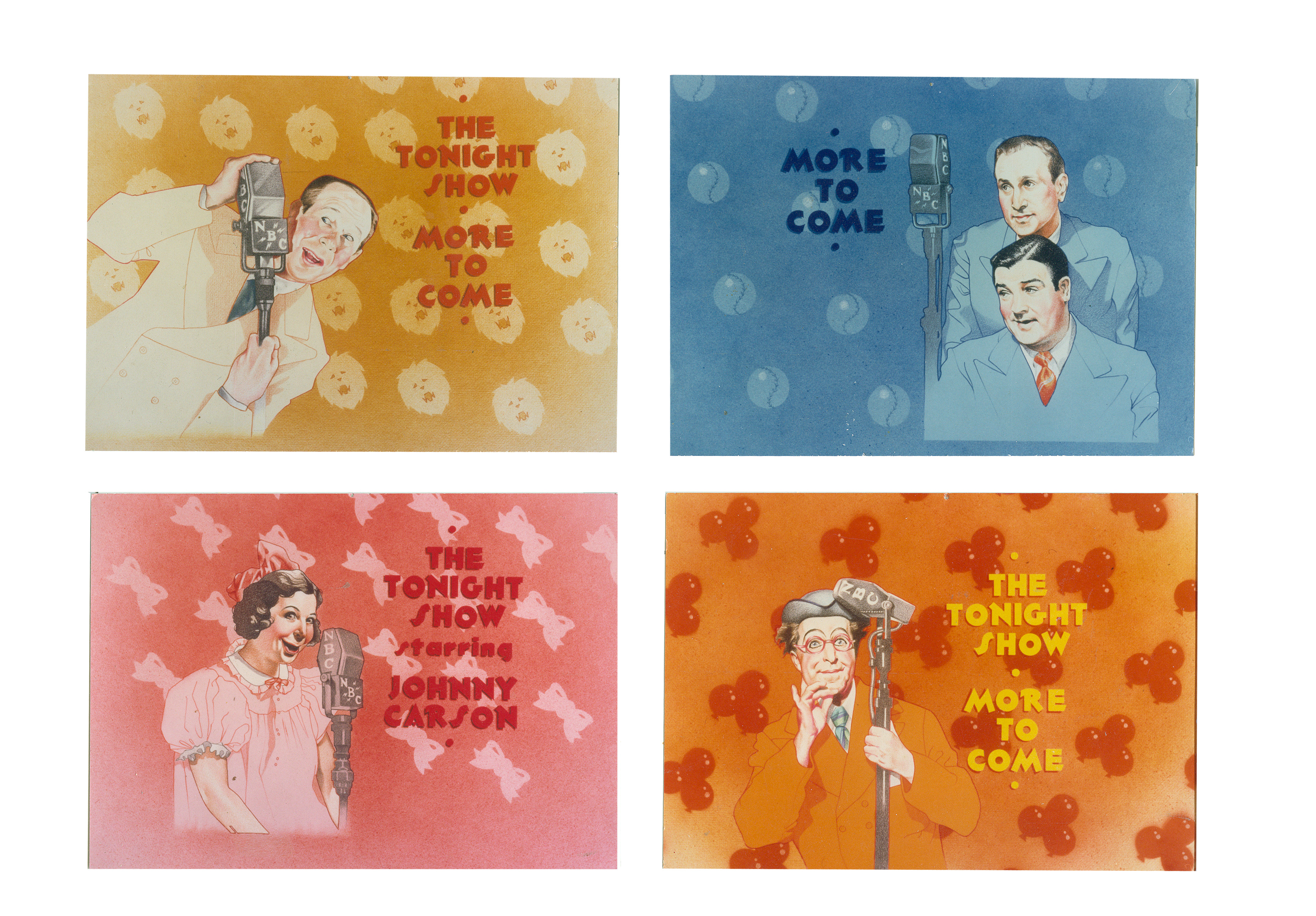
Adkins
himself has had quite a remarkable career in Hollywood. To learn
more about his art and work, go to hollywoodandart.com
and historyforhire.com.
He
was also able to provide info on the recent "ACT
ONE" illustration listed on ebay -- it wass
for a paperback book, not a movie poster -- as well as another
illustration during his early career:
BTW,
the woman in the Amsel illustration on ebay is Gertrude
Lawrence and the man on the right is George S. Kaufmann.
Amsel did a number of paperbacks in the 70s including "Crazy
Sundays" about F. Scott Fitzgerald., so that perhaps that
illustration is for a paperback version of a biography of
Moss Hart. Amsel is highly unlikely to use an image of a
famous person without actually having that person as the
subject (as other illustrators have done).
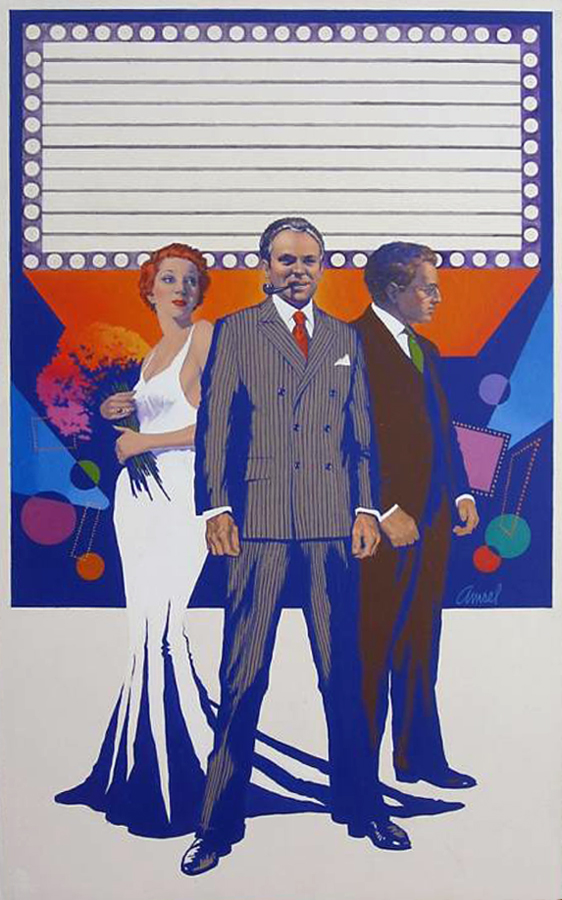 _______
_______ 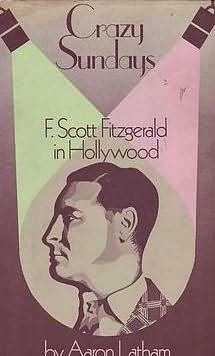
Left:
Amsel's book cover for ACT ONE by Moss Hart (likely
for Ballantine's 1970
paperback edition).
I'm still hoping to confirm this, but the timing certainly
fits in with Amsel's style during his early career.
Right:
Amsel's book cover for Crazy Sundays: F. Scott Fitzgerald
in Hollywood by Aaron Latham.
I don't know if it was for the Pocket
Books 1972
or 1975
editions, or Viking's
1971 edition.
May
3, 2010: Links of the week!
Special
thanks to the website LINKS
OF THE WEEK for including my coverage of the
Richard
Amsel TV Guide covers in their Blast From the
Past section.

April 17, 2010: More early work pops up
on eBay.
I
recently found this
eBay auction for one of Richard's early works.
Here's the writeup from the item description:
This
is an original prototype of a movie poster by Richard Amsel.
The 1963 movie was to be "Act One" and was cancelled before
production. It was to star Warren Beatty. In her book Warren
Beatty: A Private Man, Suzanne Finstad writes: "By November,
when he and Natalie Wood were back in Hollywood, Beatty
still had no plans to star in a movie, though every studio
was courting him. Act One, his passion project, was cancelled,
and Beatty had discovered a central truth about himself,
one that would contribute to his legendary reputation for
procrastination...". It measures 21" X 13". It is in overall
great condition.
I spoke
briefly to Don Baca, the owner of the piece, who had acquired
it from (of all places) a garage sale in New Mexico! I also
consulted with Dorian Hannaway, who both verified Richard's
authorship, and remembered that Richard's mother originally
owned the painting many years ago.
The film
"Act One" was actually released in 1963, without Beatty's
involvement (George Hamilton took over the role). Though I have
doubts that this illustration reflects that specific film --
neither Beatty's nor Hamilton's likenesses are to be found,
and Amsel would have only been about 15 at that time -- I am
nevertheless intrigued by the work, and would be curious to
know more.
FOOTNOTE:
Don provided these images (image
1, image
2)of writing on the back of the artwork, to
further identify the piece.
UPDATE
6/13/2010: Artist Richard
Adkins stated
that this was done not for a film but a reissue of the source
book, ACT ONE by Moss Hart. Looking through Amazon, I
suspect it was for Ballantine's 1970
paperback edition, though I'm trying to confirm.
The timing certainly fits in with Amsel's style during his early
career.
 _ _.jpg) _ _.jpg)
.jpg) _ _.jpg)
March 24, 2010: Alternate movie posters...
My
good friend (and fellow Vassar alum) Nathan Gray directed me
to this
great article about alternate poster designs inspired
by classic movies. Among them is the work of Travis
Coburn, who created "retro" style posters
of the leading nominees for this year's BAFTAS (including, lower
left, THE HURT LOCKER).
I
also found this
site, which explains the creation of a wonderful
poster (bottom center) inspired by 2001: A Space Odyssey,
done by art student Sakke Soini . Needless to say, Mr. Soini
has quite a career ahead of him.
Finally,
check out the work of graphic designer Brandon
Schaefer, whose minimalist-style movie poster
designs, while appearing deceptively simple at first, are actually
quite complex, striking, and very, very memorable. (Such an
example is his poster for EMPIRE STRIKES BACK, bottom right.)
Seeing
such extraordinary talent is both inspiring and, frankly, makes
me feel all the more insecure about my
own work in comparison.
 _ _
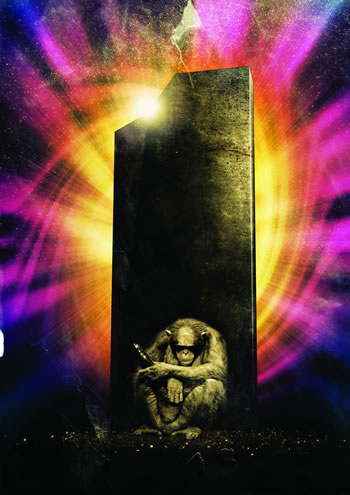 _ _
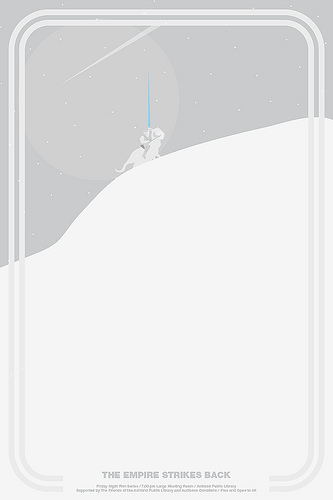
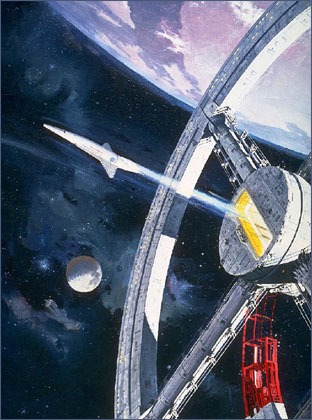 March
6, 2010:
R.I.P. ROBERT McCALL (1919-2010) March
6, 2010:
R.I.P. ROBERT McCALL (1919-2010)
“One
of the joys of being an artist is the freedom to create
one’s own world.... Like the real world, these excursions
of the imagination are fraught with inaccuracies of perception—it
is rare that one glimpses through the veil of time even
a hint of tomorrow’s reality—nor does it seem important
to me whether one’s perceptions are right or wrong, the
pleasure is in making the predictions and doing the work.”
— Robert McCall
Famed
Space Artist Robert McCall, 90, Dies
SPACE.com / Robert Z. Pearlman
Artist
Robert McCall, whose visions of the past, present, and future
of space exploration have graced U.S. postage stamps, NASA mission
patches, and the walls of the Smithsonian, died on Friday of
a heart attack in Scottsdale, Arizona. He was 90.
 Once
described by author Isaac Asimov as the "nearest thing to an
artist in residence from outer space," McCall's paintings first
attracted the public's attention in the 1960s on the pages of
LIFE, illustrating the magazine's series on the future of space
travel. He expanded on that theme at the invitation of director
Stanley Kubrick, who had McCall paint the advertising posters
for his seminal 1968 science fiction film, "2001: A Space Odyssey." Once
described by author Isaac Asimov as the "nearest thing to an
artist in residence from outer space," McCall's paintings first
attracted the public's attention in the 1960s on the pages of
LIFE, illustrating the magazine's series on the future of space
travel. He expanded on that theme at the invitation of director
Stanley Kubrick, who had McCall paint the advertising posters
for his seminal 1968 science fiction film, "2001: A Space Odyssey."
Since
then, many more have encountered McCall's space art through
canvases both very large and very small.
 Perhaps
his most famous piece, the six-story "The Space Mural — A Cosmic
View" greets visitors to the National Air and Space Museum in
Washington, D.C. Painted over the course of eight months in
1976, McCall's depiction of the creation of the universe leading
to astronauts walking on the moon is seen by an estimated ten
million annually. Perhaps
his most famous piece, the six-story "The Space Mural — A Cosmic
View" greets visitors to the National Air and Space Museum in
Washington, D.C. Painted over the course of eight months in
1976, McCall's depiction of the creation of the universe leading
to astronauts walking on the moon is seen by an estimated ten
million annually.
Others
of McCall's large murals can be found at NASA's Johnson Space
Center in Houston, Texas, at the Dryden Flight Research Center
in Lancaster, California, and at the Kansas Cosmosphere and
Space Center in Hutchinson. A number of his paintings decorated
the walls of the former Horizons pavilion at Walt Disney World
Resort's Epcot in Florida, and one remains on display at the
entrance to the park's iconic "Spaceship Earth" attraction.
At the
other end of the size spectrum but no less popular, McCall created
the art for 21 space-themed U.S. postage stamps, ranging in
subject from the moon landings to the unmanned probes sent to
Mars and Jupiter. His design for a commemorative marking the
Apollo-Soyuz Test Project adorned the largest stamp published
in the United States.
In 1981,
McCall designed eight stamps celebrating STS-1, the first flight
of the space shuttle. At mission commander John Young's request,
McCall also designed the insignia that Young and Bob Crippen
wore aboard Columbia for the two-day mission.
It was
through the stamps and patches that he created did McCall ultimately
see his artwork merge with their subject matter and enter space.
The Apollo 15 astronauts flew his "Decade of Achievement" two-stamp
pane to the Moon, and the last men to walk on the lunar surface
did so while wearing an Apollo 17 mission patch designed by
McCall.
"It is
something I continue to covet," shared McCall in a 2006 interview
with collectSPACE.com. "It was wonderful to really see this
emblem that I designed on the Moon, in real time from Mission
Control."
In 1973,
at the personal request of flight director Eugene Kranz, McCall
designed the original insignia to represent the Mission Control
teams. McCall also created patches for the third and fifth shuttle
crews, as well as the first to dock with
Russia's
Mir space station. His most recent patch was designed for back-up
spaceflight participant Barbara Barrett, a family friend, in
2009.
Continue
reading at collectSPACE.com
about McCall's path to becoming a NASA artist and his view on
the future of spaceflight.
McCall's
own website can be found here.
Jan. 29, 2010: Old yearbook paintings!
As
the song goes, "Everything old is new again...", and
so for the new year it seems fitting that a lot of Amsel's early
work has finally come my way. Perhaps the earliest work I've
seen thus far comes from Marc Walther, a high school classmate
of Richard's. Upon discovering this website, Marc emailed me
some scanned illustrations Richard had made for their 1965 yearbook.
Marc writes:
Wow,
it has been a few years. You see, you are a young guy and
I am 62. Richard's parents had a nice toy store on Lancaster
Ave., in Ardmore. I used to go in there all the time with
him. He had such amazing talent that I always knew he was
going places. It is just a shame that he passed. Actually,
I only learned about his passing this past year, through
friends at high school. In any event, the yearbook was in
1965. He was the Art Editor.
These
early images not only showcase Amsel's developing creative talents,
but provide a touching, personal look into the artist as a young
man.
 __
__ 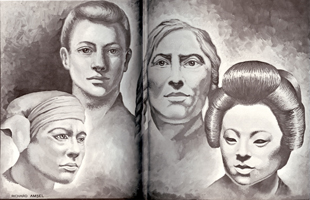
Jan.
28, 2010: Early Amsel book cover added to the gallery.
Last
night I wandered around a favorite used bookstore in downtown
Glendale when I found this old, battered paperback book perched
upon a rack. The cover caught my eye immediately, and lo and
behold, it was one of Richard's works. To make the $2.50 purchase
even more rewarding was that it was not only signed by the author,
but also by the two people he had dedicated the book to -- who,
in turn, gave the book to one of their mutual friends.
Dorian
Hannaway informed me that the original Amsel cover illustration
now resides within the University of the Arts, but this was
the first time she had actually seen a copy of the book itself.
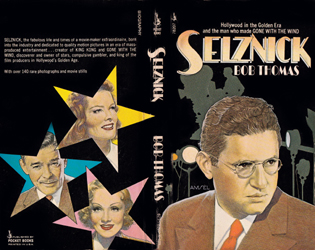
Jan.
9, 2010: Early Amsel magazine illustrations added to the gallery.
For
me, one of the most rewarding things about this site is that,
no matter how familiar I may be with Richard's work -- or at
least presume to be -- new discoveries always turn up!
American
Art Archives is selling three magazine pages on eBay
featuring Richard Amsel's work, all from 1971. I've added them
to the MISC. WORKS page, and hope you enjoy them. (I'm
especially partial to his gorgeous illustration for "The
Earring".)
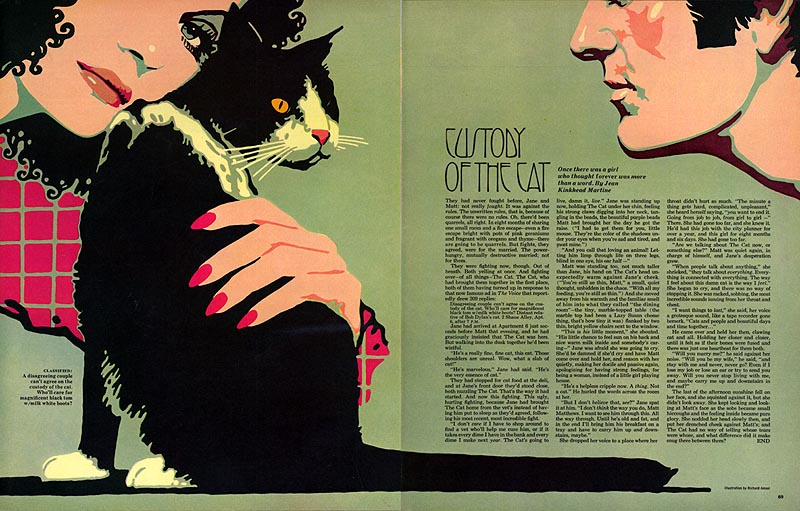 __ __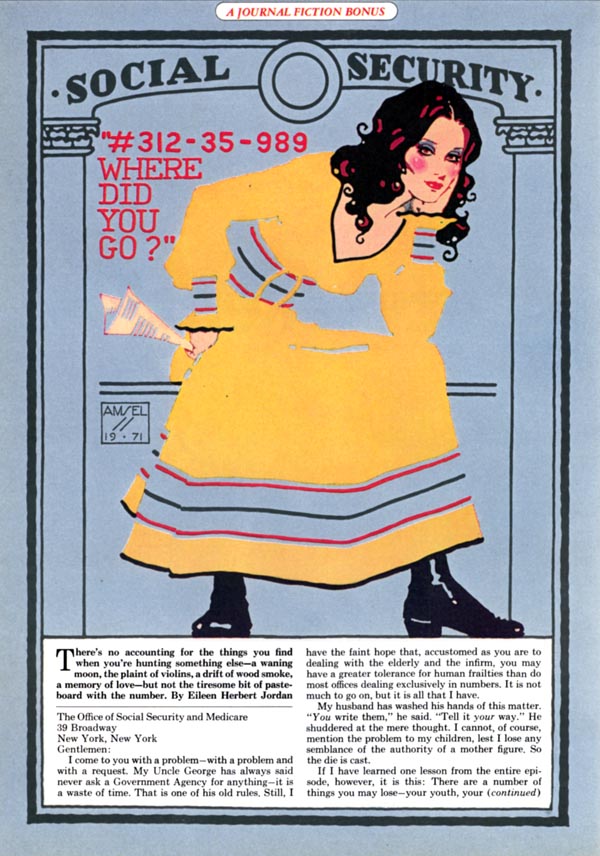 __ __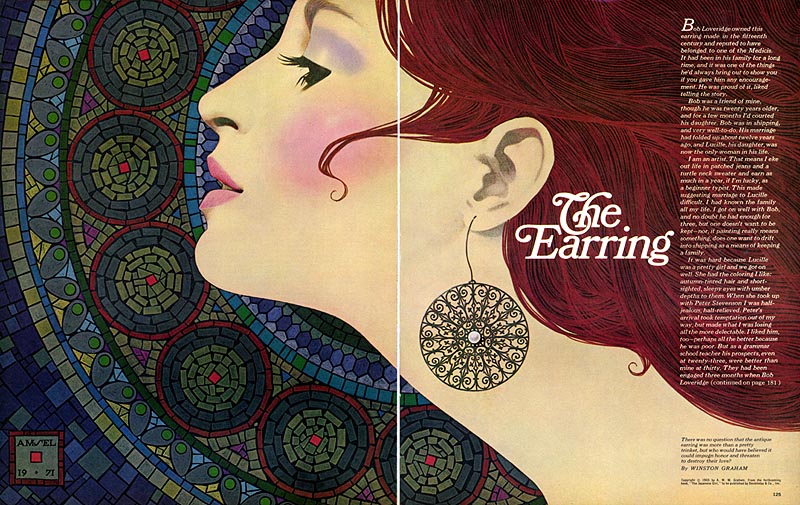
ARCHIVES
2010 | 2009
|